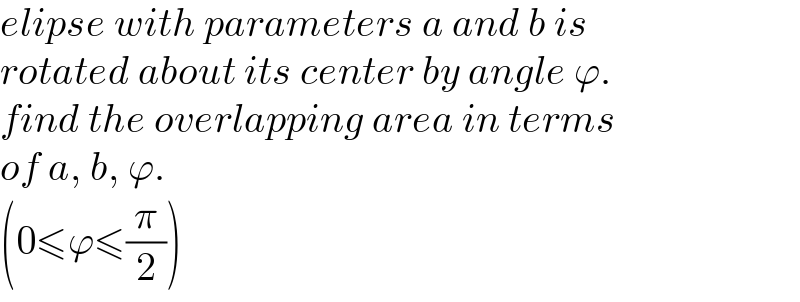Question Number 177787 by mr W last updated on 09/Oct/22

Commented by mr W last updated on 09/Oct/22

$${elipse}\:{with}\:{parameters}\:{a}\:{and}\:{b}\:{is} \\ $$$${rotated}\:{about}\:{its}\:{center}\:{by}\:{angle}\:\varphi. \\ $$$${find}\:{the}\:{overlapping}\:{area}\:{in}\:{terms} \\ $$$${of}\:{a},\:{b},\:\varphi. \\ $$$$\left(\mathrm{0}\leqslant\varphi\leqslant\frac{\pi}{\mathrm{2}}\right) \\ $$
Answered by mr W last updated on 09/Oct/22

Commented by mr W last updated on 09/Oct/22
![red elipse: (x^2 /a^2 )+(y^2 /b^2 )=1 ((r^2 cos^2 θ)/a^2 )+((y^2 sin^2 θ)/b^2 )=1 ⇒r^2 =((a^2 b^2 )/( b^2 cos^2 θ+a^2 sin^2 θ)) θ_P =(ϕ/2) θ_Q =((π+ϕ)/2)=π−((π/2)−(ϕ/2)) area of sector OPQ of red elipse: A_(sector) =(1/2)∫_θ_P ^θ_Q r^2 dθ overlapping area = 4×sector A_(overlapping) =2∫_θ_P ^θ_Q r^2 dθ =2∫_θ_P ^θ_Q ((a^2 b^2 )/( b^2 cos^2 θ+a^2 sin^2 θ)) dθ =2ab[tan^(−1) ((a/b)×tan θ)]_θ_P ^θ_Q =2ab{π−tan^(−1) [(a/b)×tan ((π/2)−(ϕ/2))]−tan^(−1) ((a/b)×tan (ϕ/2))} =2ab[π−tan^(−1) ((a/b) cot (ϕ/2))−tan^(−1) ((a/b) tan (ϕ/2))]](https://www.tinkutara.com/question/Q177809.png)
$${red}\:{elipse}: \\ $$$$\frac{{x}^{\mathrm{2}} }{{a}^{\mathrm{2}} }+\frac{{y}^{\mathrm{2}} }{{b}^{\mathrm{2}} }=\mathrm{1} \\ $$$$\frac{{r}^{\mathrm{2}} \mathrm{cos}^{\mathrm{2}} \:\theta}{{a}^{\mathrm{2}} }+\frac{{y}^{\mathrm{2}} \mathrm{sin}^{\mathrm{2}} \:\theta}{{b}^{\mathrm{2}} }=\mathrm{1} \\ $$$$\Rightarrow{r}^{\mathrm{2}} =\frac{{a}^{\mathrm{2}} {b}^{\mathrm{2}} }{\:{b}^{\mathrm{2}} \:\mathrm{cos}^{\mathrm{2}} \:\theta+{a}^{\mathrm{2}} \:\mathrm{sin}^{\mathrm{2}} \:\theta} \\ $$$$\theta_{{P}} =\frac{\varphi}{\mathrm{2}} \\ $$$$\theta_{{Q}} =\frac{\pi+\varphi}{\mathrm{2}}=\pi−\left(\frac{\pi}{\mathrm{2}}−\frac{\varphi}{\mathrm{2}}\right) \\ $$$$ \\ $$$${area}\:{of}\:{sector}\:{OPQ}\:{of}\:{red}\:{elipse}: \\ $$$${A}_{{sector}} =\frac{\mathrm{1}}{\mathrm{2}}\int_{\theta_{{P}} } ^{\theta_{{Q}} } {r}^{\mathrm{2}} {d}\theta \\ $$$${overlapping}\:{area}\:=\:\mathrm{4}×{sector} \\ $$$${A}_{{overlapping}} =\mathrm{2}\int_{\theta_{{P}} } ^{\theta_{{Q}} } {r}^{\mathrm{2}} {d}\theta \\ $$$$\:\:\:=\mathrm{2}\int_{\theta_{{P}} } ^{\theta_{{Q}} } \frac{{a}^{\mathrm{2}} {b}^{\mathrm{2}} }{\:{b}^{\mathrm{2}} \:\mathrm{cos}^{\mathrm{2}} \:\theta+{a}^{\mathrm{2}} \:\mathrm{sin}^{\mathrm{2}} \:\theta}\:{d}\theta \\ $$$$\:\:\:=\mathrm{2}{ab}\left[\mathrm{tan}^{−\mathrm{1}} \left(\frac{{a}}{{b}}×\mathrm{tan}\:\theta\right)\right]_{\theta_{{P}} } ^{\theta_{{Q}} } \\ $$$$\:\:\:=\mathrm{2}{ab}\left\{\pi−\mathrm{tan}^{−\mathrm{1}} \left[\frac{{a}}{{b}}×\mathrm{tan}\:\left(\frac{\pi}{\mathrm{2}}−\frac{\varphi}{\mathrm{2}}\right)\right]−\mathrm{tan}^{−\mathrm{1}} \left(\frac{{a}}{{b}}×\mathrm{tan}\:\frac{\varphi}{\mathrm{2}}\right)\right\} \\ $$$$\:\:\:=\mathrm{2}{ab}\left[\pi−\mathrm{tan}^{−\mathrm{1}} \left(\frac{{a}}{{b}}\:\mathrm{cot}\:\frac{\varphi}{\mathrm{2}}\right)−\mathrm{tan}^{−\mathrm{1}} \left(\frac{{a}}{{b}}\:\mathrm{tan}\:\frac{\varphi}{\mathrm{2}}\right)\right] \\ $$
Commented by Tawa11 last updated on 09/Oct/22

$$\mathrm{Great}\:\mathrm{sir} \\ $$
